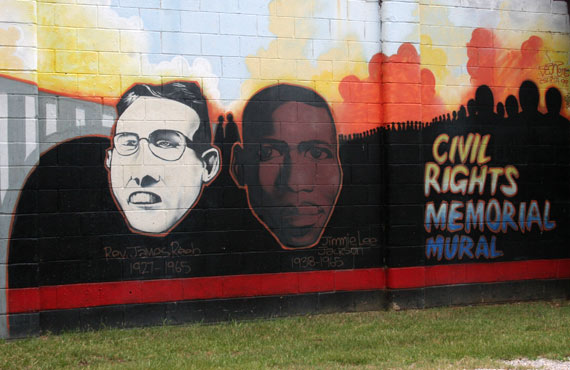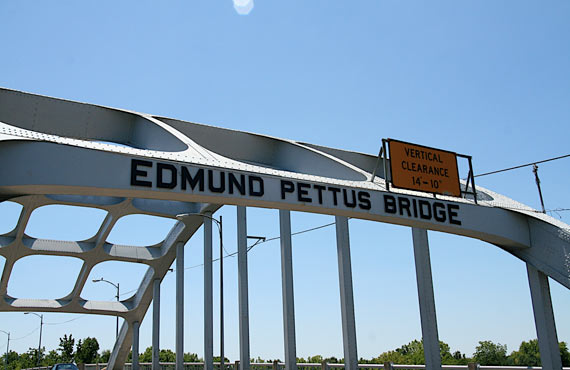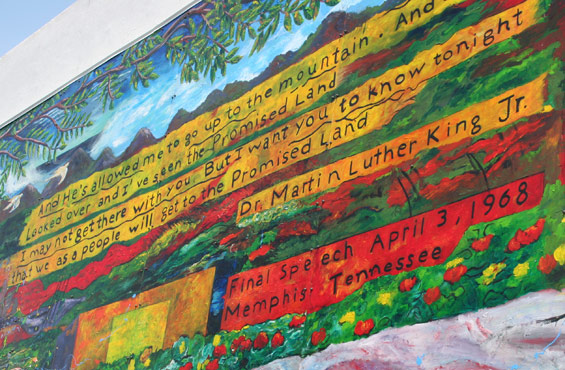
by Deva Jones | Jul 27, 2012 | Racial Justice
The following post was written by Rowan Van Ness, a UUCSJ trip leader currently on the 2012 Civil Rights Journey.
When we visited Selma and marched silently across the Edmund Pettus Bridge, I thought about the civil-rights marchers who were brutally beaten there on Bloody Sunday. I thought about the ministers who gathered there from across the country to march for equal voting rights. James Reeb, a Unitarian Universalist minister who lost his life, was among them. I asked myself: would I have marched?
As I walked across the bridge, I felt shivers run through me, despite the 95-degree weather and the sweat dripping down my back. I can’t even begin to imagine how much courage it must have taken to march across that bridge, on each and every attempt. I thought about the beautiful, solid structure of this bridge — and of the structures that continue to uphold racism and oppression, even to this day. When do we perceive oppressive structures as beautiful and comfortable?
Most of the justice work I’ve done thus far has been for environmental justice. I’ve looked at how the environmental impacts of the individualism and consumerism that weave the threads of the American Dream have a disproportionate impact of people of color. Who, even today, is most likely to live in Cancer Alley, where plastics are made? Who, even today, is more likely to live near a dump? Or have their water shut off?
James Reeb died for a movement that wasn’t his — because it actually was his. As Martin Luther King Jr. said, “Injustice anywhere is a threat to justice everywhere.” What role do we have as Unitarian Universalists today in uncovering justice issues and shining a spotlight on those doing this work? What is our role in doing this work? Will we have the courage to answer the call for justice?
Questions about the Civil Rights Journey? Contact us about this and more service-learning opportunities.

by Deva Jones | Jul 27, 2012 | Racial Justice
The following post was written by Tracey Haines, a participant on the 2012 Civil Rights Journey.
“We are not alone. We are not alone. We are not alone today.” Those were the words displayed on the movie screen at the Selma to Montgomery National Historic Trail’s Lowndes Interpretive Center. They were sung as a chorus to “We Shall Overcome,” which you can probably hum yourself. The movie was giving us historical background on the 1965 march from Selma to Montgomery, Ala., so the song was simply serving as the soundtrack in the beginning of the film — but the song and those words took on a bigger role for me later that day.
After our Civil Rights Journey group left the center, we headed toward Selma for a tour of some key sites in the civil-rights movement. One of the places I was most looking forward to seeing was the Edmund Pettus Bridge. This was the bridge from which unarmed civil-rights marchers descended into a sea of state troopers as they attempted their march to Montgomery. (They were marching to protest the murder of Jimmy Lee Jackson and to demand voting rights.) The state troopers teargassed and brutally beat the marchers, eventually turning them back. It took the marchers three tries to successfully complete the march to Montgomery, and it was fraught with hardship. They were ultimately successful and arrived at the Alabama State capitol at the end March 1965.
When walking across the Edmund Pettus Bridge — the bridge I had heard about and read about for decades — I was overcome with emotion. And those words came to me. “We are not alone. We are not alone. We are not alone today.” Did those marchers feel that way in 1965? I don’t know, but I certainly hope they found some comfort in their numbers and perhaps in their faith. All I know is that we — our group of Civil Right Journeyers — were not alone.
I’m guessing I was not the only one who felt the spirits of those who went before us as we walked in their footsteps. These people, mostly all just “ordinary” citizens, made so many things possible, including the fact that our group — black, white, gay, straight, male, female, and various ages — could walk across this bridge practically without notice and certainly without raising any alarm. We can travel together, share meals together, and meet together publicly without fear and intimidation. We were not alone today.
Questions about the Civil Rights Journey? Contact us about this and more service-learning opportunities.

by Deva Jones | Jul 24, 2012 | Racial Justice
By Sam Jones, Associate for Marketing and Enrollment
Last spring, I left a job in technology retail to begin working in the newly formed UU College of Social Justice (UUCSJ). After four years of selling phones and laptops, I wanted to return to justice work. That decision to join UUSC is what brought me here, to Atlanta, where I’m leading UUSC’s eighth Civil Rights Journey — the first ever through the College of Social Justice.
For me, the conviction for that decision came from experience in my teenage years. After high school, I joined AmeriCorps and spent two years working with youth in marginalized communities. Between working in after-school programs and organizing service projects, I helped lead a 12-week training program for high-school students that covered many facets of privilege and discrimination in the United States. After college and retail, I knew my calling was to get back to doing this kind of work.
So now, a year after starting in UUCSJ — after helping 60 people travel to Haiti and launching our programs at General Assembly — I’m leading a group of teenagers to learn not just about privilege and discrimination but about how to overcome them.
Our first day has been amazing. Hosted by the UU Congregation of Atlanta, we spent the day with George Friday, the field organizer for the Bill of Rights Defense Committee (BORDC), a UUSC civil-liberties partner. George is a dynamic woman who has been leading anti-racism and anti-oppression training for over 20 years, and her experience showed. She guided a powerful conversation that started with discussion of the origins of racism in America and ended with an exploration of the language we use to best be allies.
As we travel back to our hotel to get ready for our journey to Tuskegee and Montgomery tomorrow, the youth and adults here are energized, ready to learn, and excited to take part in this work. For me, this is a fulfilling culmination of that choice I made last spring. This journey will take us through the history of the civil-rights movement, and I am certain it will be a powerful continuation of today’s conversation.
Want to honor the legacy of the civil-rights movement and continue striving to make civil liberties a reality for all? Check out BORDC’s Local Civil Rights Restoration campaign and get involved!
Questions about the Civil Rights Journey? Contact us about this and more service-learning opportunities.



